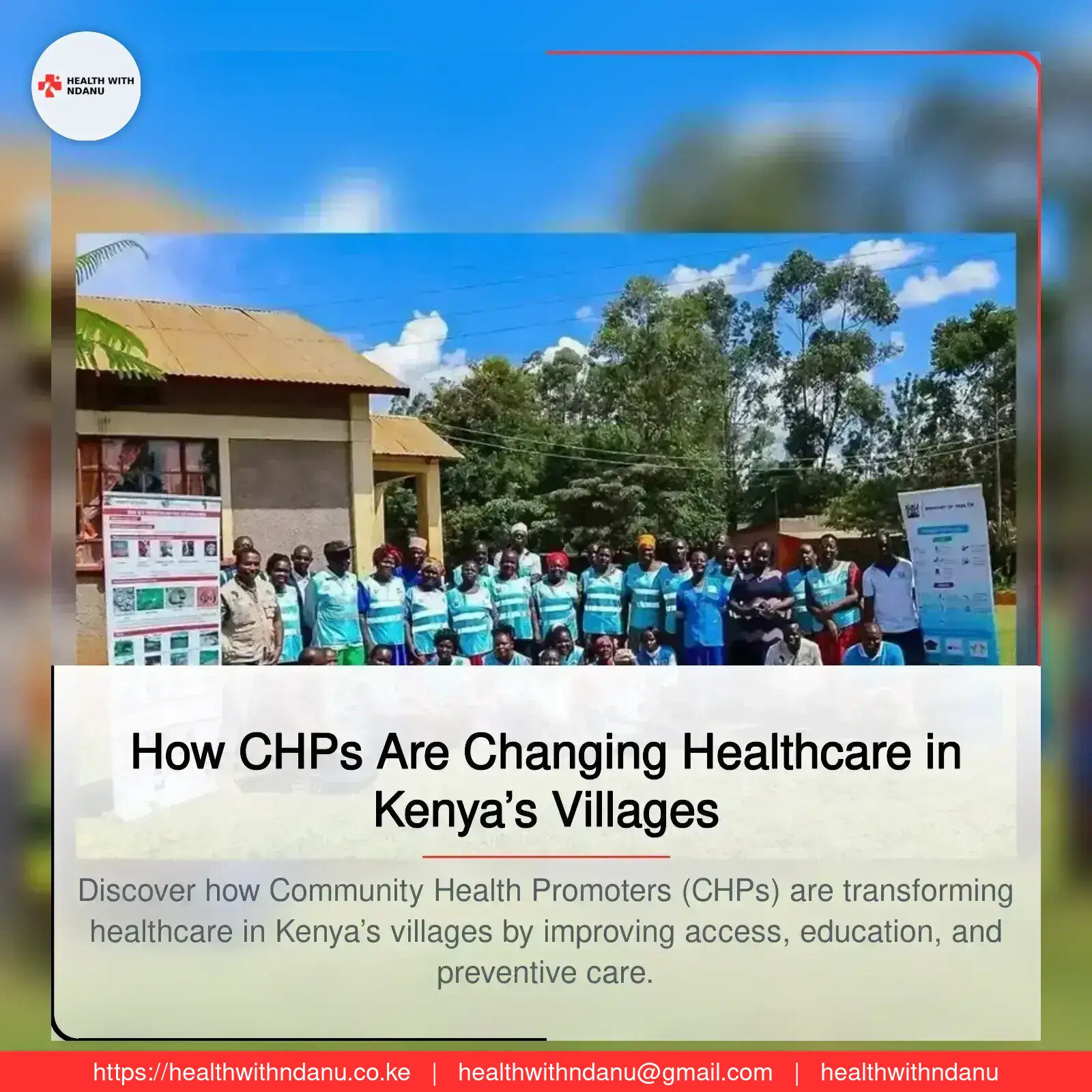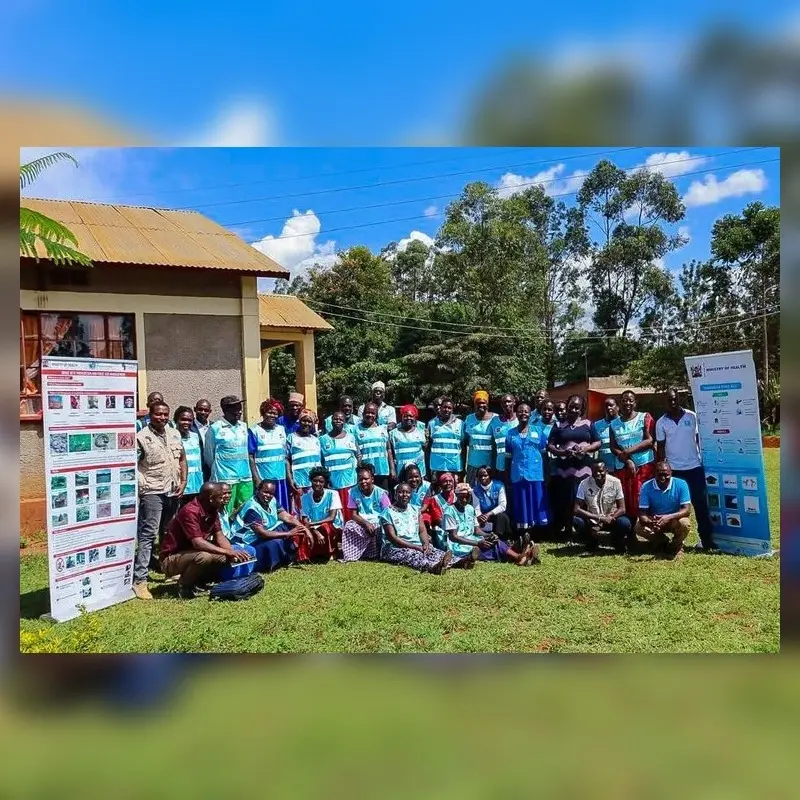How CHPs Are Changing Healthcare in Kenya’s Villages
- by Diana Ndanu
- 07 April, 2025
- 0 Comments
- 6 Mins



Introduction
In the heart of rural Kenya, where dusty footpaths lead to homes and the nearest clinic might be miles away, a quiet revolution is taking place. It’s not being led by massive hospitals or big-name doctors. Instead, it’s coming from the people — Community Health Promoters (CHPs) — and their impact is transforming the health of entire villages.
Let’s take a closer look at how these dedicated individuals are improving access to care, preventing disease, and building healthier futures, one household at a time.
Who Are Community Health Promoters?
Community Health Promoters (CHPs), also known as Community Health Volunteers (CHVs) in some areas, are trained individuals who provide basic health services and education within their own communities. They’re often mothers,father's, youth leaders, or elders chosen by the people they serve, making them relatable and trusted.
1. Bringing Healthcare to the Doorstep
In remote Kenyan villages, visiting a health facility can mean a 10–20 km walk — often while sick, pregnant, or carrying a child. For years, this reality has discouraged people from seeking care until it's too late.
CHPs are closing this gap.
They provide door-to-door visits, checking in on families, offering basic services, and referring serious cases to the clinic. From checking a baby’s weight to educating a family on safe water storage, their presence means care is just a doorstep away.
“Since Mama Achieng’ started coming to my home, I no longer wait until my child is very sick. She even taught me how to treat minor diarrhea and when to go to the clinic.” — Mary, a mother in MitiMoja, Saboti.
2. Champions of Preventive Health
While curative care gets more attention, prevention saves the most lives — and CHPs are leading the charge.
They educate communities on:
- The importance of immunization
- Handwashing and personal hygiene
- Proper waste disposal
- Breastfeeding and weaning practices
- Malaria prevention using insecticide-treated nets
By addressing risk factors before they become problems, CHPs reduce the spread of diseases like cholera, diarrhea, pneumonia, and malaria — common causes of death in rural areas.
3. Supporting Mothers and Children
Maternal and child health in Kenya has seen significant improvement, and CHPs are a big part of the reason why.
They:
- Register pregnant women for antenatal care
- Ensure safe deliveries at health facilities
- Support breastfeeding mothers
- Monitor child growth and immunization
- Follow up on malnourished or sick children
In a country where maternal deaths are still too high, these interventions are literally lifesaving.
“She came to check on me every week when I was pregnant. If it wasn’t for her, I would have delivered at home again. This time, I went to the clinic and my baby was born safely.” — Grace, mother of two in Kisumu Ndogo,Tuwan,Saboti.
4. Trusted Sources of Health Education
In many communities, misinformation and myths can spread quickly — especially about sensitive topics like contraception, vaccines, or teenage pregnancy.
CHPs play a vital role in correcting false beliefs and delivering culturally sensitive health education. Because they are part of the community, people trust them more than outsiders or posters on a wall.
They teach about:
- Family planning and spacing children
- Menstrual hygiene for adolescent girls
- Safe sex and STI prevention
- Nutrition and lifestyle for chronic diseases
By engaging in open, respectful dialogue, CHPs help shift deep-rooted beliefs and improve health-seeking behavior.
5. Using Mobile Health Tools for Real-Time Data
Gone are the days when health data was collected in bulky notebooks and forgotten. CHPs today are equipped with mobile phones and apps that help track:
- Pregnancies and births
- Malnutrition
- Disease outbreaks
- Immunization coverage
- Deaths and cause of illness
This real-time data feeds directly into county health systems, enabling faster response during emergencies, like cholera outbreaks or measles surges.
It also helps counties plan better — deciding where to deploy more nurses, build health facilities, or run outreach campaigns.
6. Empowering the Community, Especially Women
- One of the most beautiful outcomes of Kenya’s community health strategy is the empowerment of ordinary people, especially women.
- Most CHPs are women, and being a health promoter gives them purpose, respect, and sometimes, a stipend or small income. They become role models in their communities — leaders who influence behavior, advocate for the vulnerable, and speak up during public forums.
- Their work inspires young girls and builds a culture where health knowledge is passed through generations.
7. Mental Health and Adolescent Support
With rising cases of depression, substance use, and school dropouts, especially after COVID-19, CHPs are stepping in to support young people.
They provide:
- Counseling for teens and parents
- Support for adolescent mothers
- Referrals for mental health care
- Dialogue on self-esteem, peer pressure, and sexual health
- In places where mental health is still a taboo, CHPs break the silence and offer a lifeline to struggling youth.
8. Affordable Healthcare for All (UHC Vision)
- Kenya’s goal of achieving Universal Health Coverage (UHC) by 2030 depends heavily on community-level interventions. CHPs are the face of UHC in rural areas.
- Their work reduces the burden on overwhelmed clinics and hospitals. They prevent diseases, refer early, and help patients stick to medication for chronic conditions like HIV, TB, and hypertension.
- When CHPs are well supported, the entire health system becomes stronger, more affordable, and more people-centered.
Challenges CHPs Still Face
Despite their value, CHPs still face significant barriers:
- Lack of consistent pay or motivation
- Inadequate training and supervision
- Stockouts of basic supplies like gloves, ORS, or referral forms
- Burnout and heavy workloads
County governments and the Ministry of Health must invest more in supporting and sustaining this workforce if we want to see long-term impact.
What Can Be Done?
To ensure CHPs continue to transform village health in Kenya, we need:
- Regular training and refresher courses
- Fair compensation and motivation
- Supplies and tools to deliver quality care
- Recognition and career progression
- Public-private partnerships to scale success
- NGOs, development partners, county governments, and communities all have a role to play.
Final Thoughts: Everyday Heroes Changing Lives
CHPs may not wear white coats or work in big hospitals, but their impact is undeniable. They are everyday heroes quietly saving lives, shifting mindsets, and building healthier futures in Kenya’s most underserved communities.
As we walk toward a stronger, more equitable health system, let’s support, celebrate, and invest in our Community Health Promoters — because the future of healthcare begins in the home, and they’re already there.
Got Your Own Experience? Share with us
Popular Categories
Most Visited Blogs
Daily Newsletter
Get all the top stories from Blogs to keep track.



